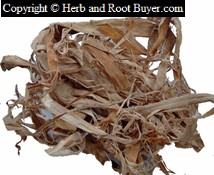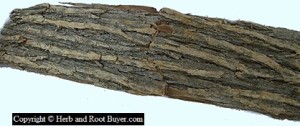Slippery Elm Bark – Ulmus rubra
|
Current Demand = Normal |
Parts Used: Inner Bark |
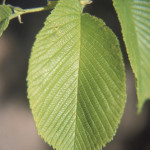 |
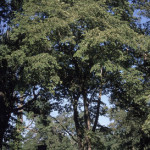 |
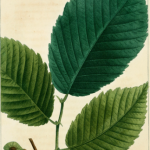 |
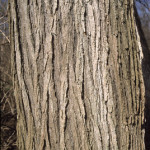 |
Family: Ulmaceae
Common Names: Vanishing Elm, Indian Elm, Moose Elm, Red Elm, Sweet Elm…
Description:
The Elm is a tall 60-80 foot, deciduous tree with fissured bark. The bark is dark reddish brown, does not show buff-colored patches or streaks when sectioned; bark fissures not as diamond-shaped as American elm. The leaves are serrated alternate, simple, ovate to oblong, 4 to 6 inches long, 2 to 3 inches wide, margin coarsely and sharply doubly serrated, base conspicuously in equilateral; dark green above and very scabrous much like sandpaper, paler and slightly scabrous or hairy beneath.
The flowers have red stamens with small, light green colors in tight clusters of 3-5, blooming from March to May. The fruit is round, papery samara less than an inch across. The surface is smooth and the seed ripen in May through June. The twigs are stouter than the American elm, slightly zigzag, ashy gray to brownish-gray, scabrous. It has false terminal buds that are chestnut brown to nearly black, and may be rusty-hairy. The tree likes to grow in woodland garden and canopy areas. It is very susceptible to Dutch Elm disease.
Harvesting/Drying:
Parts used: Inner bark
When peeling elm bark the same principles apply as with other trees. Peel only one side of the tree or branch to allow the tree to heal and continue to growing. Slippery Elm bark peels easiest from late March to early June while the sap is still flowing.
Many Slippery Elm trees begin dying off after 15 years of age. Ten year old bark is said to be the best as the trunk begins to die shortly after that. Keep in mind if the land is to be clear cut, developed or mined as timber, the timber is worth less than the bark. Trees are often harvested in the wild for their edible inner bark. Large crops are borne every 2 to 4 years, beginning after 10 years of growth.
Slippery Elm bark is used most often in rossed form. Rossed meaning the rough outer bark is removed by scraping or peeling while the bark is still fresh. Rossed inner bark will be smooth, leathery and creamy white in color. When Slippery Elm bark is chewed it becomes very slippery and mucus like. Slippery Elm bark also has a sweet smell much like butterscotch or maple syrup. Both of these traits will aid you in distinguishing between slippery elm and red or American elm.
Once your bark is rossed, it can then be taken to your local buyer for sale. If you prefer to dry the bark, lay strips of bark flat and separated in a dry area such as a barn loft, turning daily to prevent molding. Hanging strips of bark from rafters also works well for drying. The key to drying and root, herb or bark is a good combination of heat and airflow. Depending on the drying location and weather conditions bark should be dry in 3-7 days. Once the bark has dried fold strips and tie into bundles for transport to your local buyer.
Planting/cultivation:
Growing region: Elm bark can be found in areas of southeastern Canada and in the United States from Michigan south to Georgia and west to the Dakotas. However, it is most common in the Appalachian regions west to Kentucky north to Ohio and south to Tennessee. It is often found in rich moist woods and lower portions of sloped timberland, among dry hillsides and in limestone soil.
The Slippery Elm prefers a fertile soil that is in the full sun, moist and well drained. The plant also likes light, medium, and heavy soils which are acid, neutral and basic. The slippery elm is very susceptible to “Dutch Elm disease that is spread by beetles.
Seed: Germinates within a few days if sown in a cold frame. Stored seed does not germinate and should be sown in early spring. The seeds can be harvested “green” (fully developed but before it dries on the tree) and sown immediately in a cold frame. When the plants are large enough to handle, place in individual pots and grow in the greenhouse for the first winter. Transplant the plants in permanent homes by late spring or early summer.
Attributes (Images)
By François André Michaux (book author), Augustus Lucas Hillhouse (translator), iii (illustrator), eee (engraver) [Public domain], via Wikimedia Commons
 Root Buyer
Root Buyer